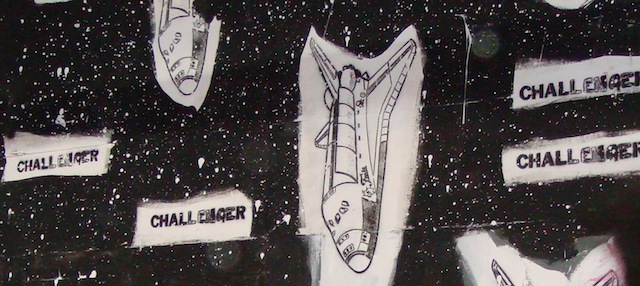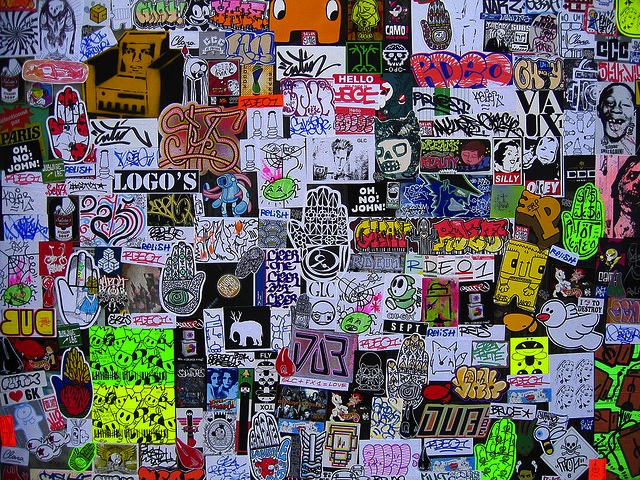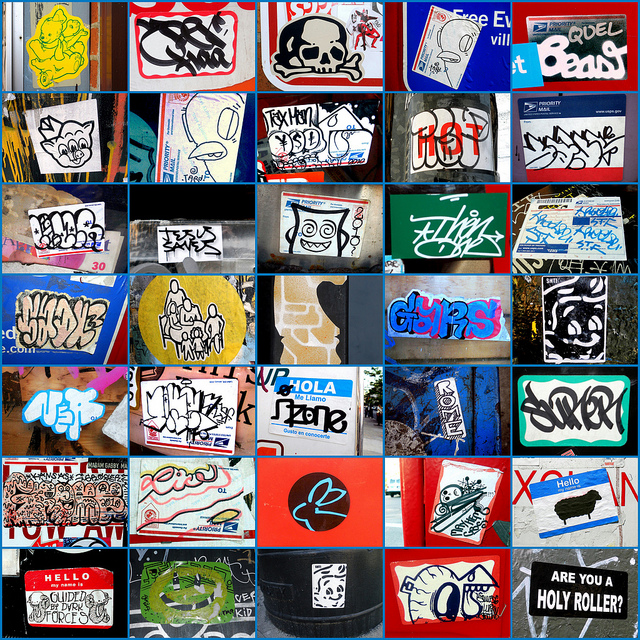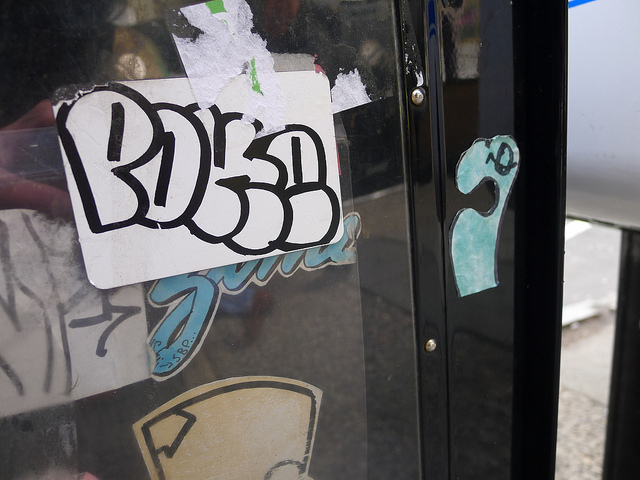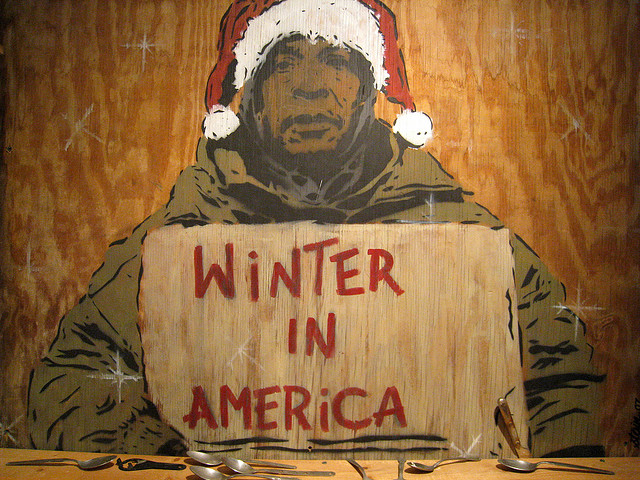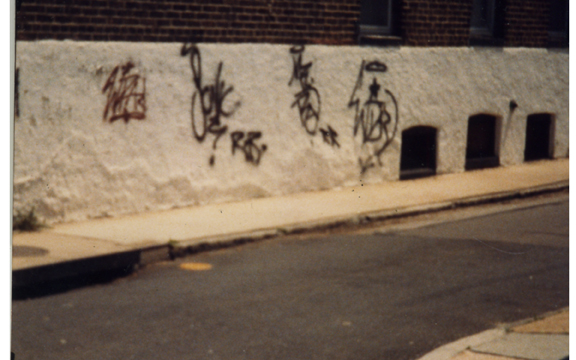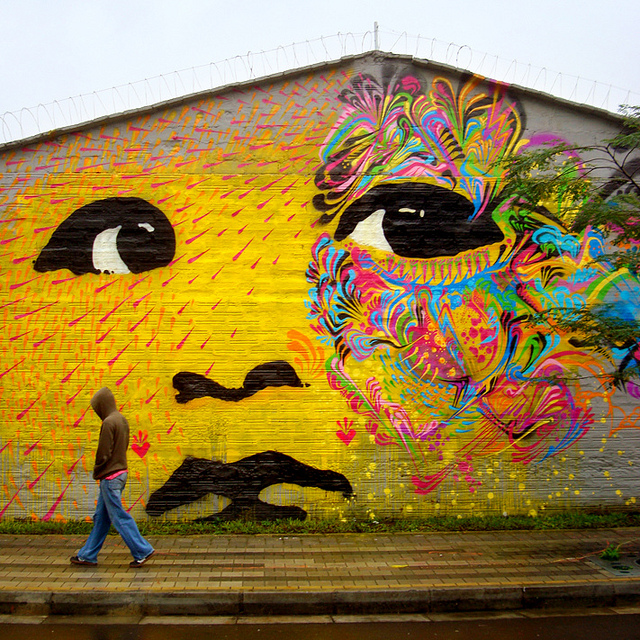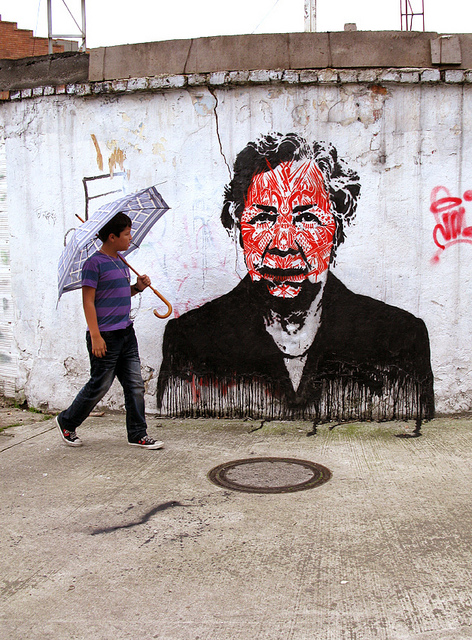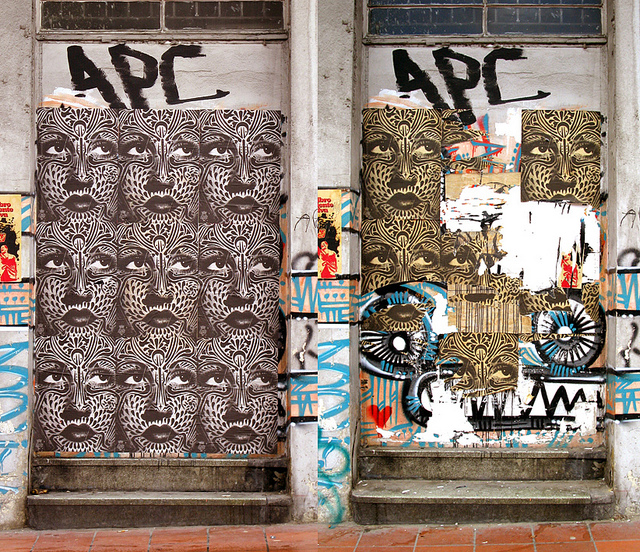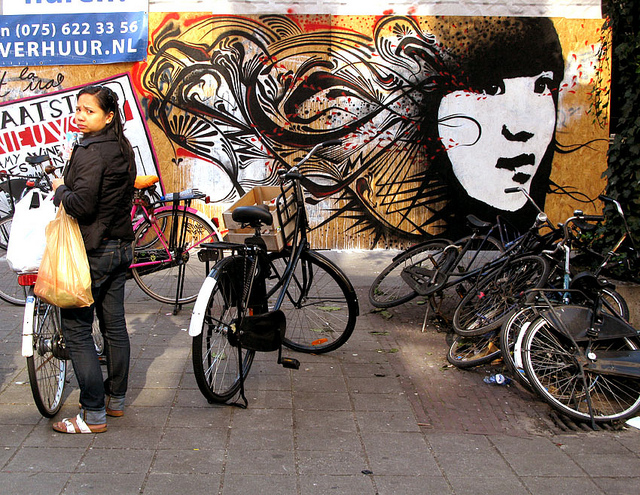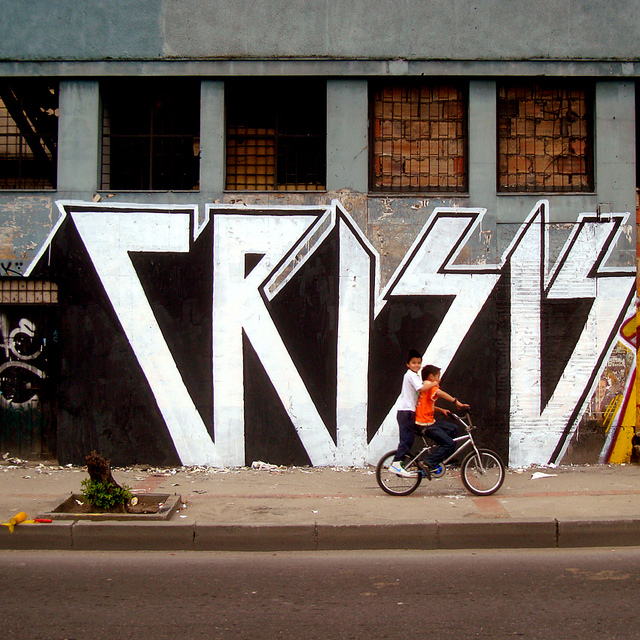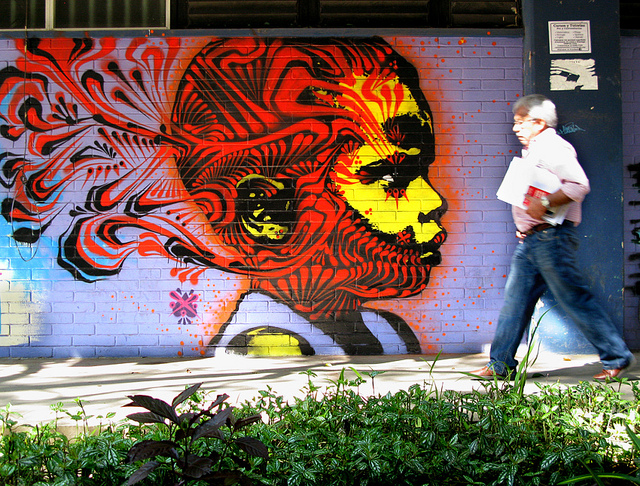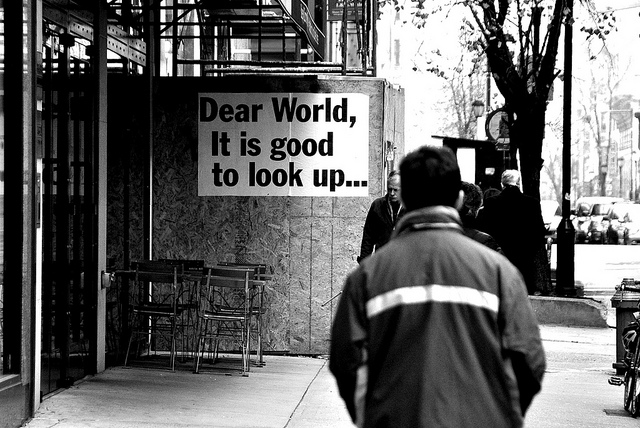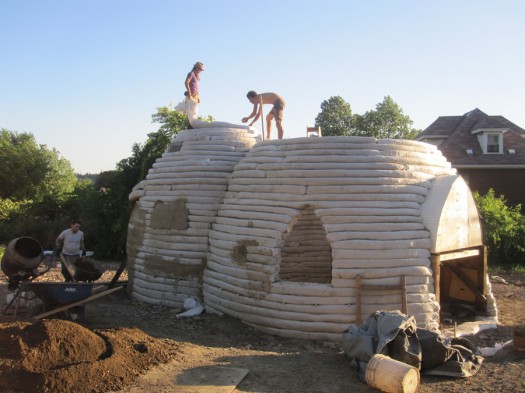
When I let RJ know I was heading up to Vancouver awhile back, he told me I had to get in touch with Scott Sueme, an artist at the forefront of aerosol abstraction who also happened to be one of the best letter-writers around. I dropped Scott a line that day, and after a few messages back and forth, we picked a day to sit down.
I first met Scott outside his studio building in Vancouver’s Downtown East Side on a night when the temperature was well below freezing. You couldn’t tell that from the look on Scott’s face though. He was wearing a Portland Trailblazers hat with the bill turned up slightly at its end, black-framed glasses, and a wide smile.
He introduced me around, quickly but warmly, as we passed through a series of first floor studios separated by half-walls and headed upstairs, only to find the end of the staircase blocked off by a construction wall. We jumped the banister and proceeded down a dark hallway before hair-pinning our way into a high-ceilinged studio.
Anchored by a foosball table, the space was productively messy–a multi-colored laboratory of experimentation. Test strips for Primary Flight littered the near wall, each a collaboration with oil painter Andrew Young.
Scott indicated that the loft was a good place to talk, so he and I climbed a thin ladder up to a small living room area, where he sat down on a stretch of faux white fur laid over a rocking chair.
Beside him were a few of his paintings from the Unintended Calculations show, specifically “Collected,” which was partially obscured by the mostly sandy-colored triangles and occasional polyhedrons of “Pressed.”
From time to time as we talked, Scott would cut his hand at these shapes for emphasis, to demonstrate how he attacks geometry in his work.

Ryan Gattis: You’ve said that you first became interested in graffiti when you hung around people that did it, so at what point did you realize that it might be the path for you?
Scott Sueme: I think I really started to take it on when I started painting alone more. When you paint alone, you get to express your true ideas, but when you’re going with someone–whether you’re each doing your own thing or you’re doing something collaboratively together–there’s a point where you just want to see your own idea through, and I picked up on that when I started going on missions to paint freights by myself. I found I got into my pocket a lot quicker and the workflow was just more fluid by myself.
RG: Last year, you took a road trip from Vancouver to L.A. to the Art in the Streets exhibit at the MOCA. What did you think?
SS: It floored me. I wasn’t expecting anything, but then I got there and the level of work blew me away. You can go to graffiti shows at galleries, but to see a museum exhibit? To be honest, it caught me off guard. One of the most memorable things was walking through TWIST’s installation, and seeing the magnitude of the work. It just consumed me, completely heightened my sensibilities as to what was possible in an indoor space.
RG: Do you feel the exhibition did everything it needed to do, in terms of showing the history of graffiti?
SS: I think it presented an objective view. I mean, there were a lot of people talking bad about it, the idea of commercializing graffiti and how it’s gotten to this point, but that’s never really been done before–an exhibit that presented the movement to the public like that. People need to see it, and I thought the information was very thorough and factual. Every artist and viewer has the right to make that decision on how they feel about it. For me, I think it was great to see that showcase; I think it spreads awareness, and I think it’s important for people to see that.
RG: We have to talk about your work in Unintended Calculations, a show you once described as “graffiti versus abstraction.” What does that phrase mean to you?
SS: First let me say that when you’ve painted graffiti for so many years, and you’re doing that aesthetic, you’re trying to emulate something. I’m trying to do a graffiti piece that looks like it’s done in graffiti style, something that pertains to certain values in the culture. So from there, the question is: once you’ve accomplished that, what’s next? You look at the simple structures of what you’re doing, and you start to break them down and you start to deconstruct the work–so it’s less graffiti “versus” abstraction. Instead, it has become a natural progression for me, to go from trying to do something really complicated and maintain the trueness to the form of graffiti, and then say, “okay, now, I want to deconstruct those elements and break them down into something more simplified.” That’s where my painting is at right now. I’m trying to use that same color knowledge and those same materials and strategies that I practice in graffiti, but I’m trying to use them in a new way.
RG: So do you find yourself more drawn to abstraction these days, or do you try to keep a balance?
SS: I think balance is important because it allows ideas to bounce back and forth. If I see something in graffiti, it might inspire a new painting, or vice versa. I keep both going and there’s always a dialogue between the two worlds, whether I’m doing something letter-based, or I’m doing something completely abstracted.
RG: Do you foresee a time for your work when they might fuse together?
SS: I feel like they’re already fusing. There are certain ways now that I block out my backgrounds behind pieces that are reminiscent of some of my abstract work, and more complex forms are making their way into my more uniform abstract work indoors.
RG: You’ve mentioned enjoying cutout letterforms, and that definitely reminded me of the triangle forms you’ve worked with in abstract pieces. Is it fair to say that’s an example?
SS: It’s totally an example, and a good one at that. My abstract paintings were initially inspired from my graffiti pieces and working with letterforms. I started to pay more attention to the negative spaces between the letters as shapes, and I saw how they made triangles. I didn’t intentionally paint them; they were just there. It’s a direct example of the idea of abstraction, as it pertains to my work. If you take away the letterforms, you would be left with the negative spaces. So, the next question is, can you create a painting of completely negative space? That’s the evolution. I went from something letter-based and switched it over, and now I’m putting all the color information that you would typically see in a letter-based graffiti piece, but now it’s in the void of what was there before. That’s the dialogue between the two works. When you’re looking at my paintings, in a way it’s a window through the negative spaces from the perspective of my work outdoors.
RG: So much of that new process must come from experience as well, because the more practice you have doing letter forms–
SS: I guess it’s when you start getting bored, or feeling restricted by the letterforms. It’s a very specific language and only graffiti writers can translate and understand what style you’re going for or how to properly read a graffiti piece. So I felt like there was more to what I was doing than just conveying that language, I wanted to reach more people with my artwork, and also get a better understanding of what it means to paint.
RG: I get that, but I also think there’s something stripped-down and zen-like about the way you’ve started seeing the negative space as the piece, as opposed to the other way around.
SS: I look at it like I have two polar opposites within me–the illustrative and the abstract. One day I can go out and do a graffiti piece and the letterforms still really excite me. But on another day I can turn that off and not try to appease that side of myself, because I find that one thing about graffiti and dealing with the subculture is that, in order to make something stylistically fitting, or make someone appreciate your work, you have to appease a crowd, or at least an aesthetic law or established form. And as an artist sometimes you don’t feel like doing that; sometimes you just feel like experimenting.
RG: Has there been a negative response in the subculture to your abstract work?
SS: Well, some people say it’s played out, or a lot of people are doing it, or they just say it’s trendy. I think they’d just rather look at graffiti than what I’m doing anyway, but there’s some controversy around it, I guess. It’s natural because that’s obviously something they recognize immediately, but what they don’t understand about my process is that I’m not actually thinking about painting triangles, or any shape for that matter.
RG: What are you thinking about?
SS: Edges. I build a painting from a single-sided edge. Each mark I make is in search of a hard, flush edge. Then I build and react around it. I react to the next one, and the next one, and so on. The painting, and the shapes eventually builds itself. I don’t actually go into a painting with the intention of creating a specific shape. In typography they say when you look at a letter, you’re not actually reading the shape of the letter but the negative space around it. This is a lot like how I create paintings, I trace the outside edges of each shape to create the flow of a painting.
RG: So your abstract work is all about finding an intuitive flow?
SS: I think that’s fair to say. When I build these edges, I’m actually looking at the edge around it and making sure it’s straight, so the shape ends up being what’s left behind after you trace the edge around it. So when you’re doing that, that’s the practice. That’s what my eye is actually doing.
RG: You’ve posted some shots of your collaboration with Andy Dixon on an installation piece for Tangled Wires at the Ayden Gallery, so it’s makes perfect sense to hear you mention building from an edge, because you can see your process as you’re going through it and how it grows organically as you’re working.
SS: Exactly. I construct the work by building off of, and around, edges–connecting them, really. I also find in most cases using tape is too restricting, I prefer just going into paint as my sole medium, it allows for more organic geometry. Which is, in a way, what graffiti is all about too, because for anyone to paint a clean piece in graffiti you have to sculpt an edge, and with my history as a designer, I work with planes and how geometric shapes fit together and work off each other. At this point, the mark-making is natural to me.
RG: I’d add one more thing to that: angles. The way you play with angles–specifically the way you might add an arrow at the end of a letter to help create movement in the letterforms–some of those bear a strong resemblance to the triangles you are using in your abstract work.
SS: Absolutely. And there are other shapes that show up in my work, squares or even diamonds, that come out of these transformations too.

Part two of The Scott Sueme Interview coming next week…
Photos by Ryan Gattis


